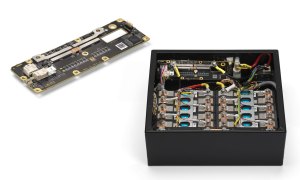Sensata Technologies has introduced its new i-BMS battery management system (BMS) for electrified applications up to 60 V. The hardware and software i-BMS15 solution with ASIL C-rated key components targets manufacturers of battery packs and low-voltage electric vehicles including 2- and 3-wheelers, automated guided vehicles, drones, and robotics. The BMS enables battery hot swapping to minimize charging time and when combined with advanced software, the solution helps to increase vehicle range, uptime, and performance.

Click for a larger image. (Source: Sensata)
The i-BMS Battery Management System from Sensata’s Lithium Balance product brand, acquired by Sensata earlier in the year, is a cell chemistry agnostic, compact, and integrated BMS that can monitor up to 15 cells in series. The i-BMS PCB board, measuring 65 x 200 mm (2.6 x 7.9 in), is said to provide everything required to manage and maintain a battery system without the need for any external components.
All critical components are pre-integrated into the system, including a pre-charge circuit, on-board current measurement, mosfet power switches for battery disconnect, and a DC/DC power supply. The solution also includes self-test capabilities for safety critical measurement circuits.
The hot swap functionality and parallel battery pack support allows for the quick exchange of depleted batteries with fully charged batteries. One example cited is the ability to quickly install fully charged batteries in the field at battery swap stations for electric motorbikes and three wheelers instead of needing to recharge for several hours, helping to alleviate the end user’s concerns around charging time.
Click for a larger image. (Source: Sensata)
The parallel pack support allows for the use of two or more battery packs in parallel. This functionality allows OEMs of 2- and 3-wheelers to have smaller battery modules, which improves the safety and serviceability of the battery system, said Sensata. “For example, if one battery cell fails while in use, the issue is isolated to that one faulty module which is easier to replace than the entire system and additional battery packs can continue to provide power.”
The i-BMS solution also comes with advanced software that helps extend battery use. The BMS Creator configuration software allows the battery pack designer to create a unique battery setup by defining application-specific BMS parameters and safety strategies. The advanced algorithms are said to deliver accurate state-of-power (SOP) predictions based on cell internal resistance, voltage and current constraints, precise state-of-charge (SOC) calculations, and (state-of-health) SOH calculated based on aging effect. It delivers SOC accuracy of ±3% and SOH accuracy of ±2% point from 80% SOH.
The high accuracy in assessing the state of the battery helps customers maximize utilization of the battery, and increase range, uptime, and performance of the vehicle, said Sensata.
Other advanced software features include measurement of rate of change of temperature to predict thermal runaway, dynamical regulation of current in extreme thermal conditions, as well as advanced parameter settings for CAN communication. The HV measurement accuracy is rated at ±100 mV, the accuracy of temperature measurement (NTC) is ±1°C over the temperature range of -10°C to 70°C, and the current measurement accuracy is ±0.5% @ 120 A. For more details, click here for the data sheet.